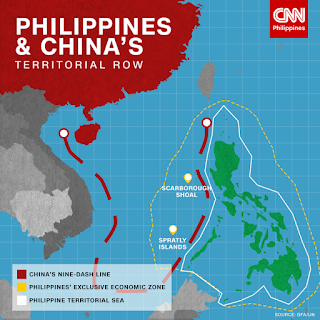West Philippine Sea Tension Part 2
In this blog, I'll try to explain in a simple language the current West Philippine Sea tension started. I do hope I get the facts right. I will show the various reference points and their timeline as sources of the tension.
The map below shows the overlapping claim of the Philippines and China in the South China Sea. The red-broken line is China's claim while the yellow-dotted line is the Philippines' claim.
Why did this happen? How did this happen? When did all of this start? What are the facts related to this situation?
In 1947, Chinese geographer Yan Huairen drew a map of the South China sea. He named each rock and reef and collectively named them as South China Sea islands. That map had been obscure for a long time. The idea surfaced again in 2009 when China presented a map, which is today's nine-dash line, to the United Nations during a territorial water dispute with Vietnam. That made the tension much clearer with us as it runs counter to our claim.
On June 11, 1978, then-President Marcos issued Presidential Decree No. 1599. The decree established the country's exclusive economic zone which is 200 nautical miles from our shores. Such a zone is a recognized principle in international law. Inside that zone, our country has exclusive rights on how we will use that zone. No foreigners can go inside that zone without permission from the Philippine government. It is for us to use and not for foreigners.
In 1982, in Montego Bay, Jamaica the United Nations Convention on the Law of the Sea (UNCLOS) was adopted in force on November 16, 1994. UNCLOS established the legal framework and defined the limits of the territorial seas of countries. The Exclusive Economic Zones were introduced as innovations of the convention. On December 10, 1982, the Convention created the International Tribunal for the Law of the Sea (ITLOS) as a judicial body that adjudicates disputes related to the Convention. Both the Philippines and China are parties to the Convention.
In February 1992, China passed a law on the Territorial sea and the contiguous zone, which lays claim to the entire South China Sea based on its historical rights to the area dating from the Xia dynasty which ruled in the sixteenth century.
In January 1996, a Philippine navy gunboat engaged three Chinese naval vessels in a ninety-minute battle near Capones Island in the Mischief Reef, a part of the Spratly chain of islands claimed by the Philippines. It was the first incident where China engaged the Philippines in military confrontation within the contested waters.
In April 2012, the Philippine warship Gregorio del Pilar was involved in a standoff with two Chinese surveillance ships in the Scarborough Shoal, an area claimed by both nations. The Philippine Navy had been trying to arrest Chinese fishermen who allegedly took government-protected marine species, but the Chinese surveillance ships prevented them. China meanwhile directed its citizen not to visit the Philippines as tourists and it put a halt on Philippine bananas export resulting in a $34 million loss.
On September 5, 2012, then-President Aquino promulgated Administrative order No. 29 naming the maritime areas on the western side of the Philippine archipelago as the West Philippine Sea. The name will be used in government maps and other forms of communications and documents.
In January 2013, the Philippines filed a case against China before the Hague under UNCLOS seeking to clarify the two countries' maritime rights in the South China Sea.
On July 12, 2016, the International Tribunal for the Law of the Sea released the final award on the case to the Philippines against China. The award declared that China's claim is incompatible with the Convention limits to the maritime zone. However, China did not participate in the proceeding and disagreed with the decision. It argued that the tribunal lacks legal jurisdiction to rule the case.
On March 7, 2021, 200 Chinese vessels were anchored in Julian Felipe reef which is within the Philippines Exclusive Economic Zone.
Secretary of Defense Delfin Lorenza lodged a protest which was downplayed by the Chinese embassy in the Philippines.




Comments
Post a Comment